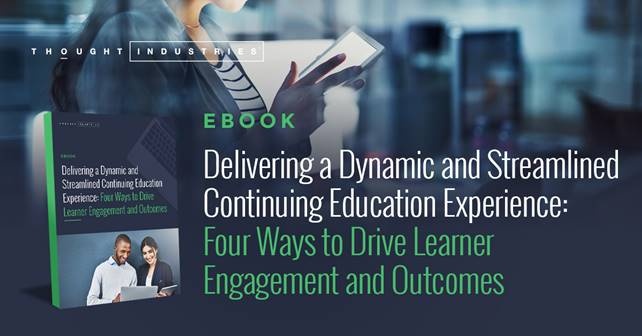Build Engagement, Measurable Learning Outcomes and Your Business with Continuing Education and Certifications
Now, more than ever, organizations are using their continuing education and certification programs as meaningful ways to help learners develop critical skills, maintain required accreditations, and stay abreast of the latest technology tools, processes, and approaches needed for professional success. Continuing Education programs and certifications have also become effective ways for organizations to establish brand awareness and authority and drive business performance and learner engagement in an increasingly virtual world.
There are a variety of ways to integrate continuing education into your education program. At COGNITION, we sat down with the following education clients to better understand how they strategized, built, and deployed their online continuing education and certification programs for their unique learning audiences and business strategies.
Investing time and resources into a continuing education, digital badging or certification program can pay off in a number of ways:
- Ongoing value and member engagement for professional associations.
- Brand awareness and marketing impact for companies that want to grow their audience and their learning program.
- While for others, offering courses as a meaningful way to give back to their customers during a time of instability by offering free courses for practitioners to hone their skills and knowledge.
Increasing ROI, retention and growth
At CentralReach, certification has become a multi-function tool that’s helping the organization forge stronger community with their practitioners and, as a result, gain a loyal and growing user base. CentralReach develops a platform for practice management and electronic health record management for professionals who work with people with autism.
“The software offers eight different administrator and specialist credentials to provide several ‘levers’ that address a variety of learner needs and strategic goals,” says David Stevens, director of the CentralReach (CR) Institute who is charged with overseeing the certification program.
The first lever of certification is helping customers become smarter about the software they’re using to increase their return-on-investment more quickly and effectively.
The second lever is helping to reduce customer turnover, boost retention, and “spread the awareness of the CentralReach program.” As Dave explains, three-quarters of the company’s market is still using “paper-and-pencil” processes and turnover is high. The online education program takes advantage of the ability to validate and track course completions and certifications. As certified professionals move from one clinic to another, they’ll take their knowledge of the program with them and “advocate” for the use of CentralReach.
The third lever, delivering Continuing Education credits (CEUs) is where the company has seen the most measurable success. Because the 40,000 behavior analysts who make up the target market are board-certified, they need to obtain CE units to re-certify every two years. The company’s library of instructional content has been designed to align with industry requirements and offers coverage for the software as well as how to run a more effective clinic.
Supporting continuing education accreditations during the pandemic
Like many industries that require continuing education and certification, the COVID-19 pandemic turned the traditional mode of in-person training and testing events upside down. CentralReach made the decision to open its entire catalog for free to help any and all practitioners in their market earn their CE credits. While the decision wasn’t intended as a business maneuver, it turned out to be a smart decision. Of the 40,000, “we got 19,000 to take advantage of our content offering. We’ve engaged with them, and that has had a humongous effect on brand awareness,” Dave marvels. “We weren’t really well known [online] in the industry at all. After this, we always came up.”
While a lot of the training content is still free, certification is rigorously structured. “We don’t want our certification to be a rubber stamp,” says Dave. “We really focus on competency.” To make sure that people know their stuff, the company has begun using Adobe Captivate on top of the tests to simulate software usage. “We’ll say, ‘Go add an insurance payer with these criteria,’ and then we can make sure that they do exactly that to further prove they actually know how to do what we are asking them to do.”
Likewise, the company is “constantly evolving” how it takes advantage of the Thought Industries learning platform in terms of making the learning and certification processes more interactive “and constantly evaluating how we do competency assessment as well so we can improve that.”
Now the company is operationalizing their learning content to lift their customer experience in a number of new ways. For instance, CentralReach plans to move content from courses into their knowledgebase to offer a better self-service resource which will ultimately reduce helpdesk tickets. They also envision recruiting some of their certified users to serve as discussion board/community space leaders who can respond to questions alongside CentralReach employees in the support forum.
CentralReach has also tapped those certified experts to help with “study groups” that do virtual live training in Zoom meetings, where people ask questions and the company does “mini presentations.” Recordings of those sessions will be added to learning content collection as another way for users to benefit from the knowledge of the certified experts. “We’re slowly working on ways to engage with our audience right in the course system itself,” says Dave.
“A certified customer makes for a better partner,” he observes. “We’re looking really to partner with our customer base, and I think our certification can help us to do that.”
Promoting timely relevance
BSA | The Software Alliance delivers the Software Asset Management (SAM) certification, which recipients earn after taking two online learning modules and passing an assessment. Although on the face of it, the association follows a more classic approach to continuing education and certifications, BSA undertook a strategic migration to optimize efficiency and improve completion rates. Plus, BSA used the sudden and dramatic shift to remote work as a conversation starter with members to emphasize the relevance of their virtual learning program.
BSA’s SAM credential isn’t targeted at its own members—companies like IBM and Microsoft—but rather to the customers of those companies, the people who acquire software assets and services for their own organizations. Also, BSA isn’t the sole force delivering the certification; it relies on partners to offer the training to their own customers too, making the multi-tenancy Panorama capability from Thought Industries “really invaluable,” according to Ha McNeill, chief operating officer. To make the certification “really stand for something” and to avoid learners becoming disconnected as they go through the training, the organization worked with a SCORM developer to institute the latest in eLearning techniques and instructional design for optimal virtual learning experiences. Ha says, “There’s check-in questions, audio, visual, and text.” Plus, there’s the test itself, which, she adds, “frankly, isn’t that easy, so you really do need to pay attention.”
To promote the existence of the credential, BSA also issues a digital badge to those who pass the test and encourages recipients to display their achievement on social media as part of creating “that sense of community.”
When people began working from home, BSA took advantage of the fact that unlike its competitors—which primarily conducted in-class training—its program was already online and self-paced. “We ran a discount promotion on the course and saw some pickup because of that,” Ha says.
Just as importantly, her organization also promoted the relevance of the topic of software asset management itself. “As everyone went remote, that only added complexity to the ecosystem. How do you make sure that you are managing all these assets, getting people up and running seamlessly overnight in a matter of days, and doing so in a way that sustains business continuity in the short, medium and long terms?” she explains. “So the topic itself is relevant to the transition that we all faced during the pandemic.”
The association also positioned the training and credential as a member benefit. “If you step back and look at it at a macro-level, more informed customers in the space make better and more loyal customers. We wanted to influence the quality and longevity of that relationship between our member companies and their customers,” Ha says. “We could do that by educating folks in this space.” For her members, building strong customer connections becomes even more important “as people move off of on-premise software to subscription-based, cloud-based software.” As she points out, “You need to have happy customers to retain them in the longer run.”
BSA learned some valuable lessons and made tweaks along the process as well. They realized that in order to sustain high learner engagement and completion of the course, it was necessary to shorten the amount of time learners could access their courses, from two years to one year and to require assessment within 90 days of course access. “The further away you get from registration, the less it’s top of mind, so the less likely you are to complete it,” Ha says.
Another tweak was to notify people about how long they had before their time ran out: “You’ve got 45 days; you’ve got 30 days; you’ve got 10 days.” That’s really helped to “focus people,” she adds. As a result, completion rates have improved significantly.
Continuing education and certification lessons learned
The common thread here is that all of these experts admitted that they didn’t know everything about leveraging online certification when they began. The key to their success was to be flexible, to learn along the way and to try new approaches to evolve the program. Their advice:
- Find a way to engage learners throughout their lifecycle. Learners may express wild enthusiasm for training in the early days, but that wanes as time goes on and life gets in the way. Seek out approaches to bring them back, re-energize them and help them keep “pushing on,” as Dave put it.
- Leverage the wisdom and input of other functions to drive overall business performance. A cross-functional approach that starts early with planning and then continues throughout– for instance, monitoring program performance, identifying opportunities and strengthening learner/customer communication—will make a big difference. That’ll save you “some headaches and lead to a better initial program,” advises Aaron.
- The technology you choose will make a big difference in how well you can manage your program, suggests Ha. That includes the learning management software, of course, but also the other programs you’ll be using—whether that’s a badging system, accreditation tracking, customer relationship application, content developer or something else. Make sure the learning platform you choose provides the kinds of integration and flexibility that are important for your operation to build and grow.
Perhaps the biggest point to remember is that all kinds of organizations are using certification and continuing education as a way to deepen their connections with customers, members, and prospects. At the same time, all have found that these programs can also drive business in meaningful ways to position organizations for long term success.
Download the eBook for additional insights:



